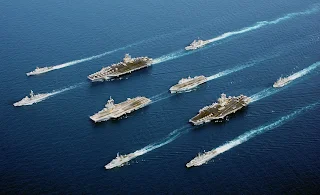Following the successful Norman and Danish invasions of England by Sea; ended in the Norman Conquest of 1066, cleared that the best way of conquering other lands and peoples was by having a strong fleet of sea-going vessels, manned by soldiers. So it was with this thought that nations realised too, that a strong navy must be built up not only for attack, but also for defence purposes.
After that concept, in middle ages, about 1100AD, ships began to change from small, rather clumsy vessels having little manoeuvrability to much larger and more seaworthy ships. These were able to travel farther and because they were more controllable, much faster than before. They did this by taking on more sail and gradually getting rid of oars altogether. Also, at this time the Portuguese, who were along with the Spanish, leaders in ship design, developed the lateen sail. This is a triangular shaped sail which allows the ship to sail against the wind, that is, heading towards the wind at such an angle that the ship is still pushed along by it.
Previously, ships could only sail before the wind. By the 12th century the compass had been invented and charts were being drawn to aid navigation. By the 15th century the great Age of Discovery had begun. Spanish and Portuguese ships travelled down the west coast of Africa and also crossed the Atlantic Ocean to South America, returning home with stories of great wealth to be had and exciting news of new worlds to be seen. Much nautical knowledge was gained through the brilliant work of Henry the Navigator, a son of King John -I of Portugal, who established a school of navigation and map-making at Sagres, bringing together the greatest experts of the time.
In 1479, another Portuguese, Vasco da Gama sailed around the Cape of Good Hope and Continued across the Indian Ocean, becoming the first man to travel from Europe to India, by sea. In 1492 the Italian explorer Christopher Columbus discovered the West Indies and in 1498 the mainland of South America. The Italian, John Cabot, sailing in the service of King Henry VII of England, set out from Bristol in 1497 and sailing westwards, discovered Nova Scotia and Newfoundland part of present day Canada.
By the beginning of 16th century the need to find a sea route to the East Indies from Europe became very important. The reason for this was due to the extremely high value of spice, which was then the only known form of preservation, especially for meat. These spices came to Europe, overland by camel caravan, from the Moluccas in the East Indies, along with silk and jade from China, narcotics from the Bay of Cambay in India, and rubies from Ceylon. This was a long, expensive and often dangerous journey, plagued by marauding bands of Turks. So, in 1519 the Portuguese explorer, Ferdinand Magellan, set out from Seville in the service of the Spanish crown, with the idea of finding an alternative sea route for the spice trade. His 3 years journey took him across the Atlantic, through the Strait that bears his name, through the southern tip of South America, past some of the bleakest and least hospitable territory on earth and into the vast Pacific Ocean. It was during this long Pacific stretch of the voyage that he encountered the terrible scourges of scurvy and starvation. However, he finally reached his destination having circumnavigated the world, and proving that a westerly sea route to the Spice Islands, as they were then called, was possible.
During the 16th century more and more exploration and discoveries were made and Henry VIII of England built larger and larger warships to meet the growing threat of war with Spain. Great sea battles in Elizabethan times followed in the mid-sixteenth century, ending that period in the defeat of the Spanish Armada in 1588. After Invention of Clipper ship, racing developed between the clippers and records were continually being made only to be broken immediately. There was a famous and beautiful American clipper, lightning that ran from Liverpool, in England, to Melbourne, Australia, in 63 days and made her return voyage in 64 days. But probably the record for the Australian run was held by the Aberdeen built Thermopylae which sailed London to Melbourne in just 60 days.
Day after day, ships are became more and more powerful and used for commercial as well as personal use along with nation armies.







No comments:
Post a Comment